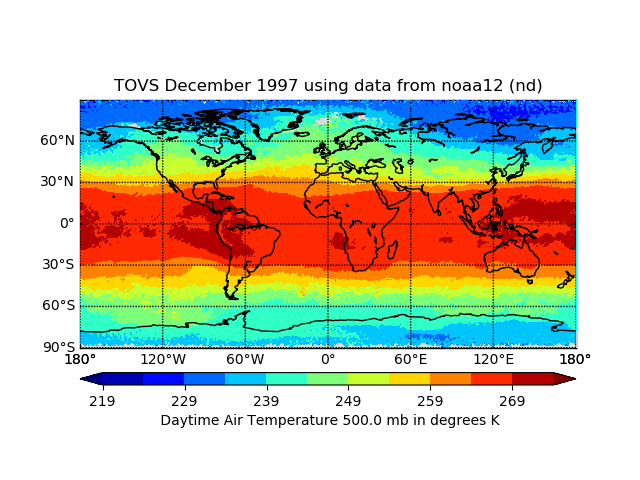TOVS GLA MONTHLY GRIDS from NOAA-12 02 (TOVSAMND) at GES DISCc
Access & Use Information
Downloads & Resources
-
Google Scholar search resultsHTML
Search results for publications that cite this dataset by its DOI.
-
Get a related visualizationPNG
TOVSAMND.V2.Dec.1997.500mb.day.temp.png
-
This dataset's landing pageHTML
Access the dataset landing page from the GES DISC website.
-
View this dataset's user's guidePDF
Contains information about the TOVS instruments and the Pathfinder Path-A...
-
View this dataset's read me documentPDF
README information for the netCDF level 3 files
-
Download this dataset through a directory mapHTML
Access the data via HTTPS
-
Use OPeNDAP to access the dataset's dataHTML
Access the data via the OPeNDAP protocol
-
Download this dataset through Earthdata SearchHTML
Use the Earthdata Search to find and retrieve data sets across multiple data...
-
Landing PageLanding Page
References
| https://doi.org/10.1175/1520-0477(1997)078%3C1449%3ACOTTPP%3E2.0.CO%3B2 |
Dates
| Metadata Created Date | March 19, 2024 |
|---|---|
| Metadata Updated Date | March 19, 2024 |
Metadata Source
- Data.json Data.json Metadata
Harvested from NASA Data.json
Other Data Resources
- Geoplatform Metadata Information
Graphic Preview

Additional Metadata
| Resource Type | Dataset |
|---|---|
| Metadata Created Date | March 19, 2024 |
| Metadata Updated Date | March 19, 2024 |
| Publisher | NASA/GSFC/SED/ESD/GCDC/GESDISC |
| Maintainer | |
| Identifier | C1548834220-GES_DISC |
| Data First Published | 1992-05-04 |
| Language | en-US |
| Data Last Modified | 2018-08-06 |
| Category | TOVS Pathfinder, CWIC, geospatial |
| Public Access Level | public |
| Bureau Code | 026:00 |
| Metadata Context | https://project-open-data.cio.gov/v1.1/schema/catalog.jsonld |
| Metadata Catalog ID | https://data.nasa.gov/data.json |
| Schema Version | https://project-open-data.cio.gov/v1.1/schema |
| Catalog Describedby | https://project-open-data.cio.gov/v1.1/schema/catalog.json |
| Citation | Goddard Laboratory for Atmospheres at NASA GSFC. 2018-08-08. TOVSAMND. Version 02. TOVS GLA MONTHLY GRIDS from NOAA-12 V02. Greenbelt, MD, USA. Archived by National Aeronautics and Space Administration, U.S. Government, Goddard Earth Sciences Data and Information Services Center (GES DISC). https://doi.org/10.5067/0V4BABVIXPA2. https://disc.gsfc.nasa.gov/datacollection/TOVSAMND_02.html. Digital Science Data. |
| Creator | Goddard Laboratory for Atmospheres at NASA GSFC |
| Data Presentation Form | Digital Science Data |
| Graphic Preview File | https://docserver.gesdisc.eosdis.nasa.gov/public/project/Images/TOVSAMND.V2.Dec.1997.500mb.day.temp.png |
| Harvest Object Id | 6ec06e60-5123-486a-b8ec-cf4ccd9c4484 |
| Harvest Source Id | 58f92550-7a01-4f00-b1b2-8dc953bd598f |
| Harvest Source Title | NASA Data.json |
| Homepage URL | https://doi.org/10.5067/0V4BABVIXPA2 |
| Metadata Type | geospatial |
| Old Spatial | -180.0 -90.0 180.0 90.0 |
| Program Code | 026:001 |
| Related Documents | https://doi.org/10.1175/1520-0477(1997)078%3C1449%3ACOTTPP%3E2.0.CO%3B2 |
| Release Place | Greenbelt, MD, USA |
| Series Name | TOVSAMND |
| Source Datajson Identifier | True |
| Source Hash | d738b0368aa8e240497d0f92fd45c519d77a9f031f4088cec3db966ed3c60e0d |
| Source Schema Version | 1.1 |
| Spatial | |
| Temporal | 1991-06-01T00:00:00Z/2022-01-17T00:00:00Z |
Didn't find what you're looking for? Suggest a dataset here.


